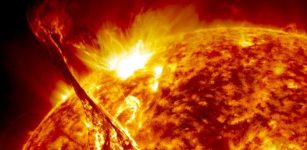Saturn Rings And Changing Seasons: Saturn’s Atmosphere: Ring Shadow And Ring Reflection
MessageToEagle.com – The Cassini spacecraft orbited Saturn from 2004 to 2017 and delivered data on the planet’s atmosphere in the region of the northern hemisphere.
The data shows the atmosphere turned from blue-tinted to gold or even salmon and it is believed that changing seasons can mean changes in the haziness and color of the skies. The stark color shift came from changes in the amount of sunlight-triggered haze in Saturn’s atmosphere, according to new research.

“I think everyone was kind of surprised by why the atmosphere was blue,” planetary scientist and the deputy project scientist of the Cassini mission, Scott Edgington, said in a press release.
Now the goal is to pin down all of the light sources that shine on Saturn and understand how the light interacts chemically with Saturn’s atmosphere.
Jupiter and Saturn have hazes that give them a golden color, while Uranus and Neptune have clearer atmospheres like Earth’s blue skies on a clear day. But as the researchers saw in Cassini images, Saturn wasn’t always covered in golden haze.
“Of course, people were scratching their heads,” Edgington said. “Why isn’t it hazy everywhere, just like Jupiter?”
In Saturn’s case, particularly limited sunlight in the winter seems to let the planet’s atmosphere recover from bouts of haziness. The reason for the extra sun protection? The planet’s massive rings.
The main driver of Saturn’s seasons is the planet’s tilt, just like on Earth. Earth is tilted so that the Northern Hemisphere faces the sun most directly in June and the Southern Hemisphere sees the sun face-on in December. In December, the Northern Hemisphere experiences long winter nights while the Southern Hemisphere enjoys its long summer days.
The same effect happens on Saturn, which is tilted about as much as Earth is. But Saturn also has an expansive ring system that blocks sunlight for the hemisphere tilted away from the sun, making winters even less sunny on the gas giant.
The planet’s changing sun exposure is responsible for the seasonal swings in its atmosphere’s haziness, Edgington said who presented his findings at the 2018 American Geophysical Union Fall Meeting in Washington, D.C.
Sunlight breaks apart methane gas molecules, which are a small but significant fraction of Saturn’s atmosphere. Methane’s breakup creates other molecules like ethane and acetylene, which trigger a complex web of chemical reactions that eventually make haze.
When one hemisphere of Saturn is enjoying a shaded winter, the haze-making process slows down. Existing haze particles clump to form heavier grains and sink further into the planet’s atmosphere and out of sight without new batches of haze to replace them.
Thanks to that, Saturnian summers tend to have hazy, golden skies, while winters have clearer, bluer skies.
“It seems like there’s a direct connection between what we see and what the chemistry tells us should happen,” Edgington said.
The researchers will continue to study Cassini’s data of Saturn’s atmosphere.
MessageToEagle.com










